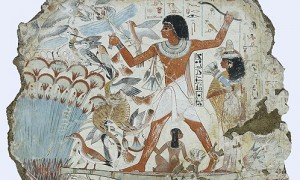One — or at least part of one — of the great agrobiodiversity-themed art works of the ancient world is back. Apart from “Fowling in the marshes,” reproduced below, Nebamun’s painted tomb includes representations of a garden pool, wine-making, and food offerings.

Photograph: The British Museum
Nibbles: Bees, Bourbon, Cattle, Ug99, Horses, Neanderthal, Bear, Organic, Flowers
- Bees? We don’t need no stinkin’ bees.
- “…a distinct product of America…”
- Friesians? We don’t need no stinkin’ Friesians.
- Kenya tests for Ug99 resistance.
- Iceland’s horses walk funny.
- Neanderthals ate snails.
- Bear meat? We don’t need no stinkin’ bear meat.
- Organic agriculture in China gets NPR treatment, survives.
- Rice? We don’t need no stinkin’ rice.
Williams honoured
Congratulations to our friend and colleague David Williams. He was co-author on a paper about ancient squash seeds that made Archaeology’s Top 10 Discoveries of 2007. Sorry we didn’t catch it earlier…
Taro in the Indo-Pacific
The 19th Congress of the Indo-Pacific Prehistory Association is going to take place 29 Nov.-5 Dec. 2009 at the Vietnam Academy of Social Sciences Conference Centre, Hanoi, Vietnam. One of the suggested sessions is on taro:
Wet Cultivation of Colocasia esculenta in the Indo-Pacific: Archaeological, Technological, Social, and Biological Perspectives.
David Addison (American Samoa Community College) and Matthew Spriggs (Australian National University)
add1ison(at)gmail.com; matthew.spriggs(at)anu.edu.auWet cultivation of taro (Colocasia esculenta) is among the most productive traditional agricultural techniques in the world, rivaled only by the homologous systems based on rice (Oryza sativa). Some of the largest stone constructions in the Pacific relate to wet taro cultivation. Research on wet taro in Oceania has focused on: the role of agricultural intensification in development of political and social complexity; aggression and territoriality; risk management; and initial island colonization. This session seeks to bring together researchers from across the Indo-Pacific region to discuss the wet cultivation of Colocasia esculenta from diverse perspectives. Participants will be asked to have papers ready for posting to a website by 1 October 2009. This will give everyone a chance to read each other’s ideas in detail. The IPPA session will then consist of short presentations and ample time for discussion. Selected participants will be asked to revise their papers immediately after the conference for publication in an edited volume scheduled for early 2010.
Thanks to Lois Englberger for the tip.
Nibbles: Brew, India, Coffee, Quinoa, Sheep, Snails, Maps
- Beer diversity to die for. Luigi comments: “Only 300?”
- Giant claims, some false, for genetic resources in North-East India.
- Coffee good for wild tree biodiversity. Joe unavailable for comment.
- How Alejandro Bonifacio saved quinoa. PROINPA comments: “And me?”
- Sheep manure’s contribution to Portuguese rye agriculture.
- Circum-Mediterranean escargotières.
- Map it or lose it.